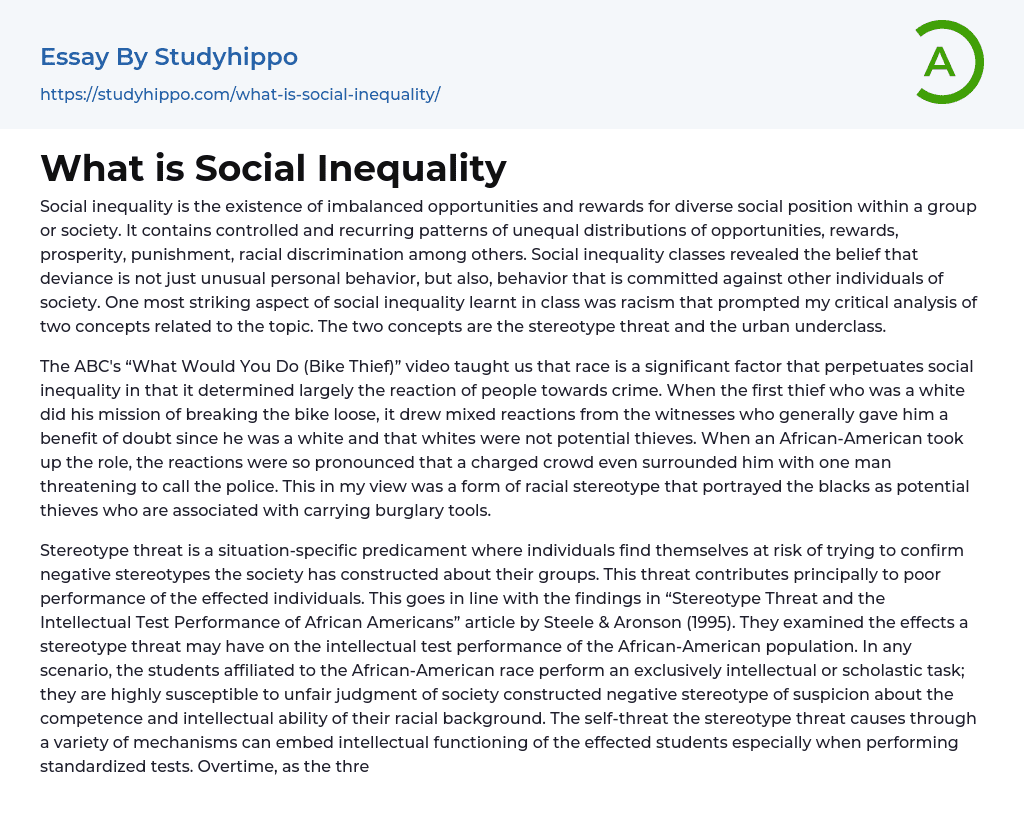Social inequality is the existence of imbalanced opportunities and rewards for diverse social position within a group or society. It contains controlled and recurring patterns of unequal distributions of opportunities, rewards, prosperity, punishment, racial discrimination among others. Social inequality classes revealed the belief that deviance is not just unusual personal behavior, but also, behavior that is committed against other individuals of society. One most striking aspect of social inequality learnt in class was racism that prompted my critical analysis of two concepts related to the topic. The two concepts are the stereotype threat and the urban underclass.
The ABC's “What Would You Do (Bike Thief)” video taught us that race is a significant factor that perpetuates social inequality in that it determined largely the reaction of people towards crime. When the first thief who w
...as a white did his mission of breaking the bike loose, it drew mixed reactions from the witnesses who generally gave him a benefit of doubt since he was a white and that whites were not potential thieves. When an African-American took up the role, the reactions were so pronounced that a charged crowd even surrounded him with one man threatening to call the police. This in my view was a form of racial stereotype that portrayed the blacks as potential thieves who are associated with carrying burglary tools.
Stereotype threat is a situation-specific predicament where individuals find themselves at risk of trying to confirm negative stereotypes the society has constructed about their groups. This threat contributes principally to poor performance of the effected individuals. This goes in line with the findings in “Stereotype Threat and the Intellectual Test Performance of African Americans”
article by Steele & Aronson (1995). They examined the effects a stereotype threat may have on the intellectual test performance of the African-American population. In any scenario, the students affiliated to the African-American race perform an exclusively intellectual or scholastic task; they are highly susceptible to unfair judgment of society constructed negative stereotype of suspicion about the competence and intellectual ability of their racial background. The self-threat the stereotype threat causes through a variety of mechanisms can embed intellectual functioning of the effected students especially when performing standardized tests. Overtime, as the threat persists, it may pressurize the students to dis-identify themselves with school performance as well as other related achievements in a bid to gain a sense of self-protection.
The urban underclass on the other hand is the population deemed to occupy the lowest position possible within the urban class hierarchy. The level is usually way below the core of the working class. The problems associated with the urban underclass have their roots in social inequality and most particularly, structural racism. This is true even considering Jencks & Peterson (2001)’s article “The urban underclass”, that posits that in spite of the disproportionate representation of the backs in the urban underclass, inner-city joblessness is largely caused by racism and discrimination. In an effort to explore the meaning of ethnicity and race to the selected employers at Chicago, the article reveals that employers perceive the inner-city employees who are mostly blacks as unstoppable, dishonest, uncooperative and with little education. Therefore, race was a determining factor that informed hiring decisions for the employers at Chicago business area and therefore, useful in analyzing the concept of the urban underclass.
In
conclusion, the video and the two articles analyzed demonstrated how social inequality through racism is so rife in the society. The two concepts of stereotype threat and the urban underclass clearly demonstrate how social inequality affects our ability to trust our judgment that we are part of society. While the stereotype threat contributes to the deviance performance in academics and other associated areas of achievement, the urban underclass fails to live up to their full potential.
References
- Jencks, C., & Peterson, P. E. (Eds.). (2001). The urban underclass. Brookings Institution Press.
- Steele, C. M., & Aronson, J. (1995). Stereotype threat and the intellectual test performance of African Americans. Journal of personality and social psychology, 69(5), 797.
- Anthropology essays
- Audience essays
- Charity essays
- Cultural Competence essays
- Emile Durkheim essays
- Gender Roles essays
- Generation essays
- Globalization essays
- Interpersonal Relationship essays
- People essays
- Race essays
- Social Change essays
- Social Class essays
- Social Movement essays
- Social Science essays
- Social Status essays
- Social Stratification essays
- Society essays
- Sociological Imagination essays
- Sociological Perspective essays
- Sociological Theories essays
- Stereotypes essays
- Web Dubois essays
- Equality essays
- Gender equality essays
- Gender Inequality essays
- Minority essays
- Segregation essays
- Social Inequality essays




